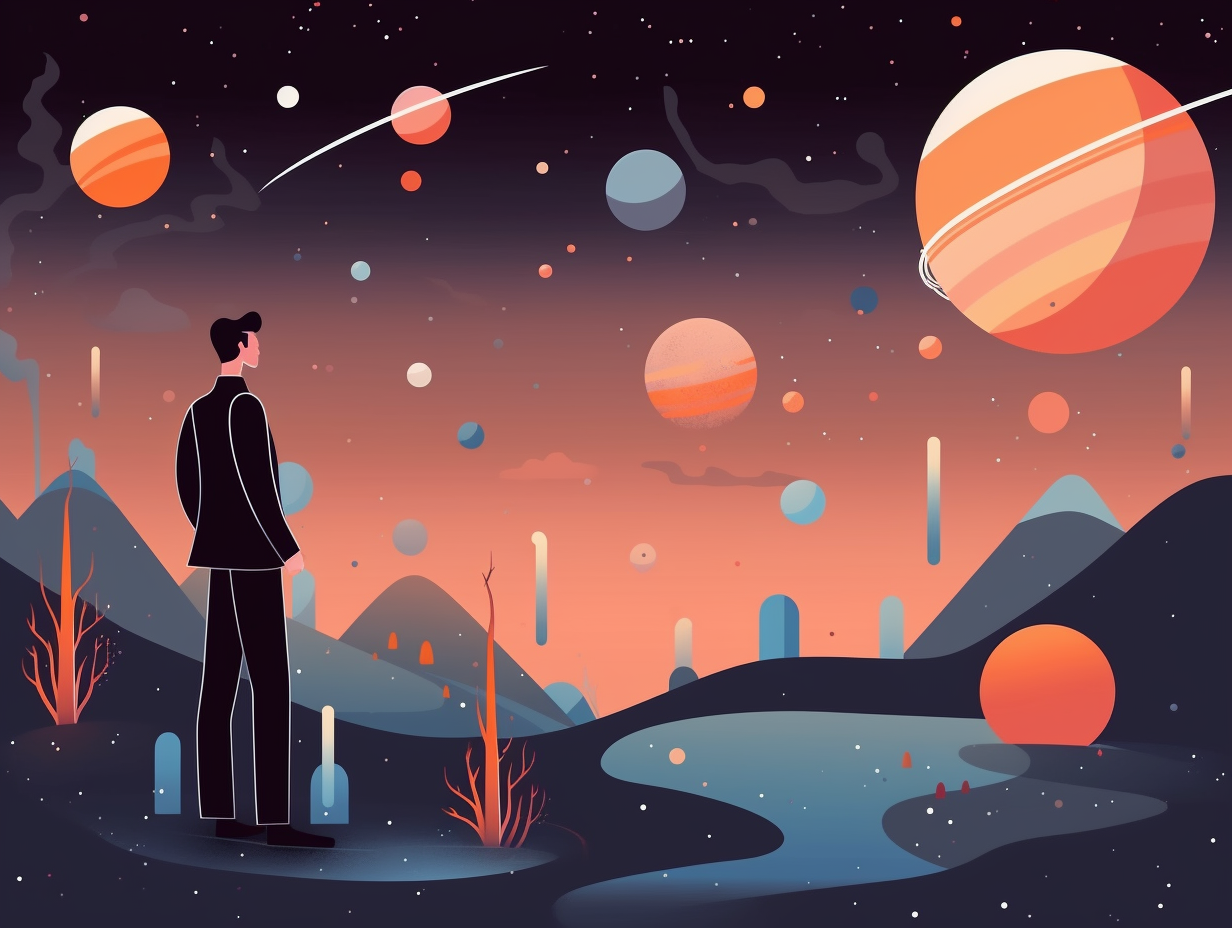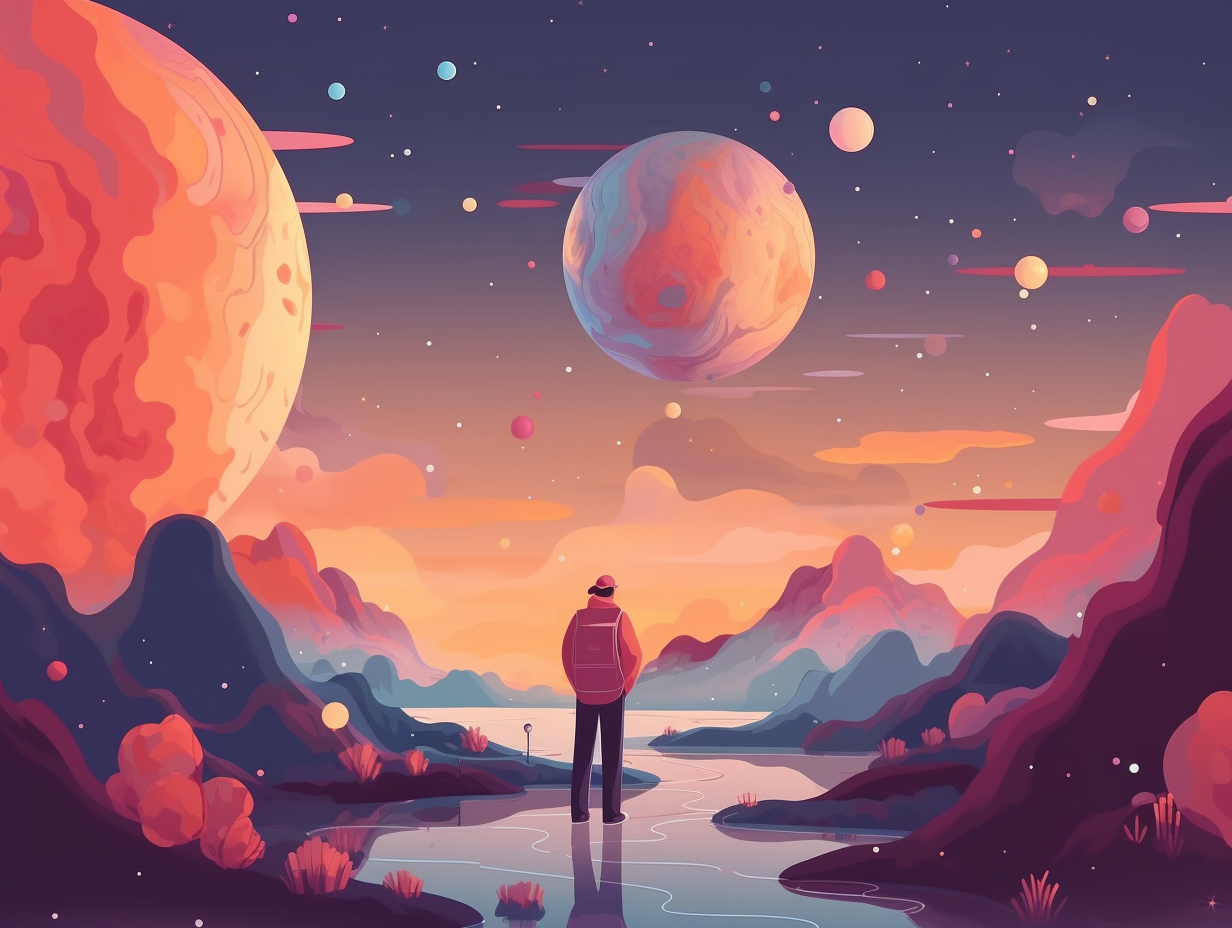27 Out-of-This-World Fun Facts About Planets You Won't Want to Miss!

1. Jupiter: Heavyweight Champ of Planets
Let's talk about our solar neighborhood's heavyweight champ, the one and only Jupiter "The Hulking Planet" – if there was an Intergalactic Planetary Wrestling Federation, it would be the reigning and undisputed interstellar belt holder: Surprisingly, this champion planet boasts a mass equivalent to 318 Earth masses, securing its position as the largest planet in our solar system; yet, its gravity is only 254% that of Earth's, all thanks to its enormous radius.
Source => hypertextbook.com
2. Venus: The Brightest Runway Model
If Venus were a runway model of the solar system, she would surely be the "brightest" of them all as she struts her celestial stuff, outshining her planetary peers: In reality, Venus truly is the brightest planet in our night sky due to its high reflectivity, with only the Sun and Moon in the heavenly hall of fame above her.
Source => usatoday.com

Did you know that bouncing on the moon's surface could be the key to maintaining bone and muscle health for astronauts? Discover how ESA's European Astronaut Centre made this out-of-this-world finding! 🌕💪
=> Fun Facts about The-Moon
3. Venus: Red Carpet Meltdown
If Venus had an official red carpet event, the theme would be "melted chic": The planet's high concentration of sulfuric acid clouds may dazzle with their distinct appearance, but the extreme surface temperature that reaches around 736 K (864°F) ensures any earthly attire or gear touching down would rapidly corrode and disintegrate.
Source => hypertextbook.com
4. Mars: Home of Olympus Mons
If Mars had a tourist brochure, it would scream "Come visit Olympus Mons, where our mountains make Everest look like a molehill!": Towering an astonishing 21.9 km (13.6 mi or 72,000 ft) high, Olympus Mons is the solar system's loftiest planetary mountain and one of its largest volcanoes, additionally boasting the grandest volcano caldera complex with six nested calderas that form a colossal 60 km (37 mi) × 80 km (50 mi) depression. This Martian marvel is even a sprightly young'un, having formed just 25 million years ago during the Hesperian period!
Source => en.wikipedia.org

5. Venus: Moonwalking Michael Jackson
In a world where most planets twirl like tops gone counterclockwise, Venus struts its stuff like a moonwalking Michael Jackson defying the norm: Venus rotates clockwise, and one full rotation takes an astounding 243 Earth days – which means a single day on Venus lasts longer than its 225 Earth-day year!
Source => coolcosmos.ipac.caltech.edu
6. Uranus: Flipping the Lid
Uranus must have been tired of the status quo, because it's really flipped its lid: The planet orbits on its side at an extreme tilt of 98 degrees, likely a result of a massive moon brushing past it and ruining its sense of balance.
Source => time.com
7. Mars: The Cosmic Ginger
Mars, the cosmic ginger of the planetary family, got its fiery personality from an astronomical makeover gone rouge: This crimson color results from the presence of iron in Mars' surface area, which has oxidized over time, reflecting red wavelengths of light and giving it that iconic redhead hue.
Source => space.com
8. Saturn: Geometry Guru
Who knew Saturn was into geometry class? As a teacher's pet, it decided to flaunt a massive hexagonal cloud formation on its North Pole: Discovered in 1981 by the Voyager mission, this stunning pattern measures about 14,500 km per side (larger than Earth's diameter), with jet streams of atmospheric gases moving at a whopping 320 km/h, all while staying perfectly stable in longitude – a unique planetary fashion choice indeed.
Source => en.wikipedia.org
9. Mars BAR Express: Your Spaceship Alternative
Who needs a spaceship when you've got a Mars BAR Express? Buckle up, because it's time to zip between Earth and Mars at a speed that's out of this world: NASA's New Horizons spacecraft reaches a whopping 36,000 miles per hour, cutting down your Mars trip to just 39 days at its closest approach, 162 days at its average distance, or 289 days when we're at the farthest we can get. But remember to pack a hearty interstellar picnic, as there's only one open window to catch this Mars-bound express every 26 months when the planets align just right!
Source => nineplanets.org

10. Saturn's Hula Hoop Rings
If Saturn's rings were a celestial hula hoop, Earth and the Moon could comfortably fit inside with room to spare: Saturn's main rings span a diameter roughly double the Earth-Moon distance, while the mysterious Phoebe ring extends even larger and thicker than the outermost E ring, thanks to studies by interplanetary probes and astronomers.
Source => physicistfarmer.blogspot.com
11. Neptune's Great Dark Spot: Now You See It, Now You Don't
They say "here today, gone tomorrow," but for Neptune's Great Dark Spot, it's more like "here today, gone a few years later": This massive anticyclonic storm, similar to Jupiter's Great Red Spot, was first spotted by NASA's Voyager 2 in 1989, but it has since vanished and reappeared in different forms and locations, leaving scientists pondering its origins and migrations.
Source => en.wikipedia.org
12. Jupiter: Champion Moon Collector
Step aside, bunny parents and octomoms: Jupiter is the Solar System's ultimate moon collector! Boasting a cosmic crèche of celestial satellites: Jupiter takes the crown with a whopping 63 known moons orbiting around it, making it the planetary champion of astronomical child support.
Source => msnucleus.org
13. Venus: Speedy Cloud Race
Venusian clouds must have taken a speed-reading course, skimming their way around the planet like a student cramming before an exam: Winds on Venus can reach up to 224 miles per hour, rapidly circulating the thick clouds that envelop the planet every four days, creating a sweltering 900 degrees Fahrenheit atmosphere that outshines Earth's mundane seasonal fluctuations.
Source => space.com
14. Europa: Ocean Current Good Vibrations
Europa, Jupiter's moon, is giving the Beach Boys a run for their money with its very own good vibrations: Scientists discovered that the moon's ocean currents are more concentrated near the equator, which could potentially make Europa even more accommodating to alien life, as the currents enhance nutrient transport from the seafloor to the ice shell – surfing, anyone?
Source => space.com

15. Uranus' Moons: A Shakespearean Ensemble
It's no tempest in a teacup, but rather a tangled web of cosmic Shakespearean drama orbiting Uranus: 25 out of its 27 moons are named after characters from the Bard’s plays, with the remaining two paying homage to a poem by Alexander Pope. The moons' namesake tradition, however, wasn't helmed by Uranus’ discoverer, William Herschel – he simply dubbed them 'number one' and 'number two'. The curtain rises on the true genius behind this celestial ensemble, none other than John Herschel, William's son and an illustrious astronomer in his own right.
Source => folger.edu
16. Saturn: Olympic-Sized Icy Ring Rain
Picture Saturn as a cosmic swim coach, constantly filling up Olympic-sized pools with icy ring rain from its celestial shower: This astounding spectacle, currently being observed by the James Webb Space Telescope and Hawaii's Keck Observatory, showcases how Saturn's intense gravity causes particles from its icy rings to descend onto the planet's upper atmosphere at a rate that could either see its luminous rings fade away in 300 million years or persist in all their splendor for another 1.1 billion years, depending on the planet's orbit and tilt.
Source => weather.com
17. Jupiter: A Sauna-Hearted Giant
Jupiter's got a hot heart: so hot it would make a sauna feel like the Arctic! But don't bother packing your towels and spa gear—this might be a celestial meltdown in progress. With a sizzling core temperature of around 35,000°C (63,000°F), Jupiter's insides are hotter than a microwave mishap and only started to catch scientist's attention in the 1990s. There are suspicions of it being a massive solid rock core up to 18 times the mass of Earth, possibly surrounded by layers of metallic and molecular hydrogen: a cosmic club sandwich that keeps us guessing!
Source => space.com
18. Uranus and Neptune: The Ice Giant Lovebirds
Living together in icy matrimony, Uranus and Neptune may be an old married couple, but they're not getting many guests these days: Voyager 2 remains the only spacecraft to have paid a visit to these frigid lovebirds, with no plans in sight for future travel arrangements, although proposals have been made to study gravitational waves while observing the ice giants.
Source => space.com
19. Asteroid Belt Party Zone
If you assumed the galaxy's ultimate party zone was between Mars and Jupiter, you're right on the asteroid belt: A dazzling collection of solid objects called asteroids or minor planets chilling approximately one million kilometers apart. The life of the party is the dwarf planet Ceres, boasting a mean diameter of 950 km and responsible for a whopping 3% of our Moon's mass. Next time you're stargazing, raise a toast to these cosmic revelers who never cease to rock(et) our universe!
Source => en.wikipedia.org
20. Mercury: The Icy-Hot Surprise
While Mercury might not be the "coolest" planet in the solar system, it certainly knows how to chill out and stay icy in the hottest of neighborhoods: Researchers have discovered water ice and organic material in permanently shadowed craters near Mercury's north pole, surviving despite sizzling surface temperatures of up to 800°F, all thanks to comets or asteroids playing the role of cosmic ice cream trucks.
Source => news.mit.edu
21. Mercury's Long Slow Days
If Mercury was a DJ, it would play one loooong song for its guests, because it's just too cool to follow the regular rule of days: A day on Mercury actually lasts a staggering 176 Earth days, while the time for the Sun to boogie back to the same spot in their sky takes a mere 88 Earth days. As for their dance floor? The polar regions never stop chilling in the shadows, flaunting an icy twist of water ice and organic molecules.
Source => universetoday.com
22. Earth: Exclusive VIP Pass
Why did the human cross the galaxy? To find another planet with free oxygen, of course! But as it turns out, the solar system gave Earth an exclusive VIP pass: it's the only planet blessed with an atmosphere filled with life-sustaining, plant-produced oxygen, the perfect distance from the sun to keep liquid water flowing, and H2O aplenty, making it the ultimate hotspot for complex life like ours to kick back and thrive.
Source => space.com
23. Jupiter: The Cosmic Clock Speedster
When it comes to punching the cosmic clock, Jupiter might just be the ultimate speedster in our planetary gang: this gas giant completes a full pirouette in a mere 9 hours and 55 minutes, leaving Earth's 24-hour spin and Mars' 24-hour-37-minute waltz eating its interstellar dust.
Source => rmg.co.uk
24. Jupiter's Great Red Spot: A Storm That's Slimming Down
Hold on to your telescopes because Jupiter's got a little wardrobe malfunction: its once enormous Great Red Spot, a turbulent storm at least twice as big as Earth itself, has been shrinking for decades and is now 10,250 miles across – the smallest it's ever been! The storm's waistline is cinching in at 580 miles per year, transitioning from its former oval shape to a more circular one, leaving experts scratching their heads at the unexpected celestial slim-down.
Source => hubblesite.org
25. Europa: Smoothest Ice Skater
If Jupiter's moon Europa were an ice skater, it'd glide to victory as the smoothest performer in the Solar System: With an icy surface covering a liquid ocean, Europa is the smoothest object out there - all thanks to Jupiter's gravitational pull keeping its subsurface ocean liquid and its icy surface moving like plate tectonics.
Source => forbes.com
26. Jupiter's Mysterious Core
Jupiter's core is like a cosmic game of Clue: is it magma, solid rock, or a melting mess? The real answer would make Sherlock Holmes sweat more under his deerstalker cap: Scientists estimate its temperature to reach a scorching 35,000 degrees Celsius (63,000 degrees Fahrenheit), but are still uncertain about its solidity. Some theories argue for a molten core, while others advocate for a solid rock up to 18 times Earth's mass, and recent findings even hint at a potentially melting state.
Source => space.com
27. Pluto and Charon: The Cosmic Dance Duo
Ladies and gentlemen, introducing Pluto and Charon - the Fred Astaire and Ginger Rogers of celestial bodies: a cosmic tango where this duo twirls around in space, connected by an imaginary rod, while four teeny-weeny moons boogie around them, forming one chaotically choreographed dance number that sometimes makes the sun a no-show, or at least rise fashionably late in different corners of the sky!
Source => arkansasonline.com
Related Fun Facts




















